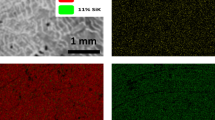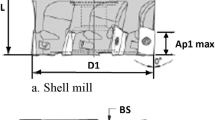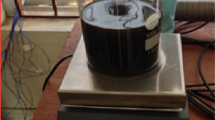Abstract
The increased demand for smaller features leads to miniaturization of components in many areas such as aerospace, biomedical, and electronic industry. Since the tribological performance of the machined components is highly influenced by surface characteristics, the analysis of environmental-friendly lubrication techniques such as minimum quantity lubrication (MQL) using vegetable oil is an important area of interest for the sustainable machining. MQL is a promising technique that minimizes the usage of lubricant, thus enhancing sustainability. This work aimed at studying the size effect and improvement in surface characteristics of sunflower oil-based MQL-assisted micro-endmilling of Inconel 718 with respect to dry machining. Chip analysis was also conducted to confirm the findings. Effects of feed/tooth on surface roughness, chip formation, top burr height, and top burr width for both dry and MQL conditions were studied. The size effect was found to be up to a feed/tooth value near to the cutter edge radius (3 µm). Minimum uncut chip thickness was found to be near to 0.3 times the cutter edge radius. It was found that almost 32% average reduction in areal surface roughness, 36% average reduction in top burr width, and 37% average reduction in top burr height were observed for sunflower oil-based MQL-assisted micro-endmilling of Inconel 718 compared to dry condition. Finally, it was concluded that the application of sunflower oil-based MQL enables micro-endmilling of Inconel 718 for higher feed/tooth range with good surface quality.














Similar content being viewed by others
References
Masuzawa T (2000) State of the art of micromachining. CIRP Ann 49(2):473–488
Camara MA, Rubio JCC, Abrao AM, Davim JP (2012) State of the art on micro-milling of materials, a review. J Mater Sci Technol 28(8):673–685
Zhanqiang L, Zhenyu S, Wan Y (2013) Definition and determination of the minimum uncut chip thickness of microcutting. Int J Adv Manuf Technol 69:1219–1232
de Oliveira FB, Rodrigues AR, Coelho RT, Souza AF (2015) Size effect and minimum chip thickness in micromilling. Int J Mach Tool Manuf 89:39–54
Ng CK, Melkote SN, Rahman M, Kumar AS (2006) Experimental study of micro and nano scale cutting of aluminum 7075-T6. Int J Mach Tools Manuf 46:929–936
Aramcharoen A, Mativenga PT (2009) Size effect and tool geometry in micromilling of tool steel. Precis Eng 33:402–407
Swain N, Venkatesh V, Kumar P, Srinivas G, Ravishankar S, Barshilia HC (2017) An experimental investigation on the machining characteristics of nimonic 75 using uncoated and TiAlN coated tungsten carbide micro-end mills. CIRP J Manuf Sci Technol 16:34–42
Ko SL, Dornfeld DA (1991) A study on burr formation mechanism. J Eng Mater Technol 113(1):75–87
Gillespie LK (1979) Deburring precision miniature parts. Precis Eng 1:189–198
Lee K, Dornfeld DA (2005) Micro-burr formation and minimization through process control. Precis Eng 29:246–252
Aurich JC, Dornfeld D, Arrazola PJ, Franke V, Leitz L, Min S (2009) Burrs-analysis, control and removal. CIRP Ann-Manuf Technol 58:519–542
Vipindas K, Kuriachen B, Mathew J (2019) Investigations into the effect of process parameters on surface roughness and burr formation during micro end milling of TI–6AL–4V. Int J Adv Manuf Tech 100(5–8):1207–1222
Nakayama K, Arai M (1987) Burr formation in metal cutting. CIRP Ann Manuf Technol 36:33–36
Schaller T, Bohn L, Mayer J, Schubert K (1999) Microstructure grooves with a width of less than 50 µm cut with ground hard metal micro end mills. Precis Eng 23:229–235
Mathai GK, Melkote SN, Rosen DW (2013) Effect of process parameters on burrs produced in micromilling of a thin nitinol foil. J Micro Nano-Manuf 1:021005–1–021005-10
Zhang T, Liu ZQ, Xu CH (2013) Influence of size effect on burr formation in micro cutting. Int J Adv Manuf Technol 68:1911–1917
Pansare VB, Sharma SB (2016) Chip load-responsive optimization of micro-milling of engineering materials. J Braz Soc Mech Sci Eng 38:2063–2068
Sooraj VS, Mathew J (2011) An experimental investigation on the machining characteristics of microscale end milling. Int J Adv Manuf Technol 56:951–958
Vipindas K, Anand KN, Mathew J (2018) Effect of cutting edge radius on micro end milling: force analysis, surface roughness, and chip formation. Int J Adv Manuf Tech 97:711–722
Lekkala R, Bajpai V, Singh RK, Joshi SS (2011) Characterization and modeling of burr formation in micro-end milling. Precis Eng 35:625–637
Thepsonthi T, Ozal T (2012) Multi objective process optimization for micro-end milling of Ti–6Al–4 V titanium alloy. Int J Adv Manuf Technol 3:903–913
Vogler MP, DeVor RE, Kapoor SG (2004) On the modeling and analysis of machining performance in micro-endmilling, part I: surface generation. J Manuf Sci Eng 126:685–694
Ramosa AC, Autenrietha H, Straußa T, Deuchertb M, Hoffmeistera J, Schulzea V (2012) Characterization of the transition from ploughing to cutting in micromachining and evaluation of the minimum thickness of cut. J Mater Process Technol 212:594–600
Boswell B, Islam MN, Davies IJ, Ginting YR, Ong AK (2017) A review identifying the effectiveness of minimum quantity lubrication (MQL) during conventional machining. Int J Adv Manuf Technol 92(1–4):321–340
Tamang SK, Chandrasekaran M, Sahoo AK (2018) Sustainable machining: an experimental investigation and optimization of machining Inconel 825 with dry and MQL approach. J Braz Soc Mech Sci Eng 40:374. https://doi.org/10.1007/s40430-018-1294-2
Muaz M, Choudhury SK (2019) Experimental investigations and multi-objective optimization of MQL-assisted milling process for finishing of AISI 4340 steel. Measurement 138:557–569
Hassanpour H, Sadeghi MH, Rezaei H, Rasti A (2016) Experimental study of cutting force, microhardness, surface roughness, and burr size on micromilling of Ti6Al4V in minimum quantity lubrication. Mater Manuf Process 31(13):1654–1662
Ucun İ, Aslantaş K, Bedir F (2014) The effect of minimum quantity lubrication and cryogenic pre-cooling on cutting performance in the micro milling of Inconel 718. Proc Inst Mech Eng Part B Eng Manuf 229(12):2134–2143
Kajaria S, Chittipolu S, Adera S, Hung WN (2012) Micromilling in minimum quantity lubrication. Mach Sci Technol 16(4):524–546
Li KM, Chou SY (2010) Experimental evaluation of minimum quantity lubrication in near micro-milling. J Mater Process Technol 210(15):2163–2170
Rahman M, Kumar AS, Manzoor-Ul-Salam (2001) Evaluation of minimal of lubricant in end milling. Int J Adv Manuf Technol 18(4):235–241
Manoj KK, Sarda J, Ghosh A (2014) Potential of vegetable oil as micro lubrication/cooling medium for SQL-grinding. In: Dixit US, Narayanan RG, Sankar MR (eds) 5th international and 26th all India manufacturing technology, design and research conference (AIMTDR 2014), IIT Guwahati, Guwahati, India, 12–14 December 2014, pp 387:1–387:5
Vazquez E, Gomar J, Ciurana J, Rodríguez CA (2015) Analyzing effects of cooling and lubrication conditions in micromilling of Ti6Al4V. J Clean Prod 87:906–913
Rahman M, Seah WKH, Teo TT (1997) The machinability of Inconel 718. J Mater Process Technol 63:199–204
Special Metals Co. (2019) https://www.specialmetals.com/assets/smc/documents/inconel_alloy_718.pdf. Accessed 19 Nov 2019
da Silva LR, Bianchi EC, Fusse RY, Catai RE, Franca TV, Aguiar PR (2007) Analysis of surface integrity for minimum quantity lubricant-MQL in grinding. Int J Mach Tool Manuf 47(2):412–418
NareshBabu M, Anandan V, Muthukrishnan N, Santhanakumar M (2019) End milling of AISI 304 steel using minimum quantity lubrication. Measurement 138:681–689
Acknowledgement
The authors would like to sincerely thank Department of Science and Technology, Ministry of Science and Technology, Govt. of India, for providing support to carry out this work under the FIST scheme (Sanction No. SR/FST/ETI-388/2015).
Author information
Authors and Affiliations
Corresponding author
Additional information
Technical Editor: Adriano Fagali de Souza.
Publisher's Note
Springer Nature remains neutral with regard to jurisdictional claims in published maps and institutional affiliations.
Rights and permissions
About this article
Cite this article
Anand, K.N., Mathew, J. Evaluation of size effect and improvement in surface characteristics using sunflower oil-based MQL for sustainable micro-endmilling of Inconel 718. J Braz. Soc. Mech. Sci. Eng. 42, 156 (2020). https://doi.org/10.1007/s40430-020-2239-0
Received:
Accepted:
Published:
DOI: https://doi.org/10.1007/s40430-020-2239-0




